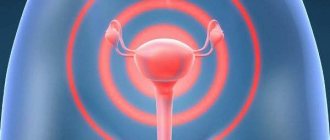Diagnosis of pregnancy is of particular interest not only within obstetric practice - knowledge of its principles will not hurt people who are quite far from medicine.
The fact is that quite a lot of time passes from the moment of conception to the appearance of obvious signs of its result. Therefore, various indirect manifestations have long been identified, which are less or more likely to indicate the development of pregnancy. Now, due to the widespread use of modern technologies, the significance of such symptoms is gradually being lost. But conceiving a child is not always a planned process - a woman may not expect pregnancy to develop at all. Despite the information content of a blood test for hCG, its implementation is most justified only no earlier than the 10th week. How then can one suspect that an embryo is already growing and developing in the uterine cavity?
For such purposes, since the last century, there have been various signs indicating the development of pregnancy. For ease of use, they were divided into several groups according to their information content. Individually, they are not of particular value (except for probable signs), so their assessment is usually carried out comprehensively. Moreover, each group of symptoms acquires its significance during certain periods of pregnancy.
Questionable signs
These manifestations, although they carry the least value for the researcher, arise the earliest. The maximum limit for their appearance is no more than 4 weeks from the moment of conception. The development of such signs is characterized by a number of common points:
- The greatest severity of symptoms (especially subjective) is typical for women for whom this is the first pregnancy.
- The intensity of the manifestations also depends on the age of the pregnant woman - the younger the girl, the more pronounced they will be.
- Characteristic is a gradual and sequential development of symptoms - only extremely rarely do they occur simultaneously. Moreover, a woman may not necessarily experience all the phenomena that will be listed below.
- Subjective symptoms always appear first, and only after them do objective symptoms appear. Moreover, the former are characterized by relative instability - they can repeatedly strengthen and weaken, appear and disappear again.
- Objective manifestations after development usually persist throughout the entire period of gestation, and gradually disappear only in the postpartum period.
Presumable signs of pregnancy serve more so that the woman herself can suspect this condition in herself before going to see a doctor.
Subjective
The essence of these phenomena is a change in a woman’s well-being, as well as some physiological functions. But the problem is that their severity and character in individual cases varies greatly. Therefore, subjective doubtful signs of pregnancy should be listed only in general terms:
- First of all, this is the lability (instability) of the nervous system. It manifests itself as severe drowsiness or insomnia, a feeling of malaise and weakness, and frequent mood swings.
- In connection with these same processes, intolerance to certain odors is noted - especially colognes and perfumes, tobacco smoke. They cause a woman to experience attacks of dizziness and nausea.
- There is a change in food preferences and appetite - an irresistible craving for certain dishes and products appears, along with an aversion to others.
- Mostly in the morning hours, a transient feeling of nausea occurs, which may even be accompanied by a single act of vomiting.
- Increased urination, not accompanied by pathological symptoms, is also a dubious sign of pregnancy, especially in combination with other phenomena.
- A transient feeling of tension in the mammary glands, as well as their increased sensitivity, appears a little later than other manifestations. Although often the onset of pregnancy is warned only by its occurrence.
Most pregnant women associate such manifestations with the development of early toxicosis, although this approach is incorrect. Unlike symptoms that have a pathological origin, they are not persistent and do not disturb the general condition of the woman.
Objective
This group of signs includes only those phenomena that the woman herself or the doctor can see during the examination. Unlike subjective symptoms, their occurrence is characteristic not only of early pregnancy. Therefore, their comprehensive assessment can be carried out in any trimester:
- The first to be noted is the appearance of foci of increased pigmentation, caused by progressive changes in hormonal levels. The most characteristic localizations are the areola and the white (midline) line of the abdomen. Less commonly, such areas appear on the skin of the face.
- Not earlier than the second trimester, stretch marks appear - red or pink “pregnancy stripes” on the skin of the abdomen, thighs and mammary glands. Their occurrence is due to the complex effect of progesterone on the female body.
- For later periods, the presumptive sign is an objective enlargement of the abdomen. Quite often, women turn to a doctor only after “suddenly” discovering this phenomenon.
Questionable symptoms are only the first stage in diagnosing pregnancy, on the basis of which one can only suspect this condition. But at the same time, their assessment is the simplest and most accessible in the early stages.
Signs of pregnancy. Why do they ask about them?
There are only a few reasons why women are interested in searching for information about signs of pregnancy:
- The woman really wants a child and tries to make sure that pregnancy occurs as quickly as possible in any possible way.
- The partners had unprotected sexual intercourse, and the woman suspects pregnancy.
- Changes occur in a woman's body that make her suspect pregnancy.
In all these cases, I would like to warn the woman against excessive worry about this. You don’t need to try on other people’s life situations for yourself, much less ask for advice on forums or from “advanced” friends in this matter. If the desired pregnancy has occurred, its real, and not far-fetched or externally imposed, signs will definitely make themselves felt.
When a pregnancy turns out to be unwanted, a woman has up to 6 weeks to undergo a medical abortion, and another 5-8 weeks to mentally and physically prepare for a mechanical abortion.
Quite often, this period plays a decisive role in order for the pregnant woman to change her mind and decide to keep the child.
- There is another reason why women look for information about signs of pregnancy; it can be called “idle curiosity” or “just in case.” This kind of curiosity is very commendable. The knowledge a woman receives from professionals allows her to save her nerves and helps her make the right decision not in a fit of emotion, but in a balanced and constructive manner.
To put things in order, let’s turn to how it is customary to designate signs of pregnancy in medicine. Experts identify doubtful and probable signs of pregnancy.
Possible signs
From this stage, a professional assessment of the specific manifestations present or absent in the woman is carried out. Therefore, all detected symptoms are purely objective - their detection and confirmation is possible only with the participation of a doctor. Almost all of them relate to the transformation of the genital organs during pregnancy:
- The most characteristic, but at the same time the most nonspecific manifestation is the absence of regular menstruation - delay (physiological amenorrhea). In this case, the main condition for its assessment is the previously existing normal menstrual cycle in a woman of reproductive age.
- When examined in the speculum, cyanosis is noted - a bluish coloration - of the vaginal mucosa and the outer surface of the cervix. This symptom can only be assessed by examination by a doctor.
- During a gynecological two-handed examination, an increase in the size of the uterus is determined, as well as changes in its other parameters. To characterize the detected phenomena in obstetric practice, specific clinical symptoms are used.
- In women who are conceiving for the first time, probable signs of pregnancy also include the appearance of drops of colostrum on the nipples when pressure is applied to them.
A positive result from rapid tests used for confirmation at home also belongs to the group of probable signs. Elevated hCG values measured in the blood have similar value.
Clinical symptoms
To standardize the data obtained, some characteristic features were named after the scientists and doctors who first discovered and described them. Most of the symptoms listed below existed before, but now they serve precisely as possible manifestations of pregnancy:
- A general criterion that is not sufficiently specific is uterine enlargement. It can be detected during a simple examination no earlier than the 12th week, when the bottom of the organ reaches the level of the upper edge of the symphysis pubis, or is located slightly higher.
- The Horwitz-Hegar sign is determined during a two-manual gynecological examination. It characterizes the softening of the uterus (mainly in the lower segment), which allows the doctor to make indirect contact with the fingers through the soft tissue.
- Chadwick's sign is used to reflect the bluish color of the vaginal mucosa found during a simple speculum examination.
- Piskacek's sign describes a change in the symmetry of the uterus during the first weeks after conception, which is detected during examination. The change in the shape of the organ is due to the attachment and growth of the embryo in the area of one of the corners. Over time, this phenomenon disappears.
- The Gauss and Gubarev sign also characterizes a decrease in the elasticity of the uterus - upon examination, increased mobility of the cervix is determined, which does not affect the body of the organ.
- A similar mechanism explains the appearance of Snegirev’s symptom, indicating variability in soft consistency. Against the background of mechanical irritation (pressure), a noticeable contraction and thickening of the uterus occurs, which soon disappears on its own.
- Genter's symptom is found quite rarely. It is confirmed when a thickening in the form of a dense ridge is detected on the anterior surface of the uterus.
Most of the listed signs are available for assessment in the period from 5 to 8 weeks, which allows us to say with sufficient confidence about a positive outcome of conception even in the first trimester.
Reliable signs
The nonspecific nature of the previously listed symptoms is due to the fact that in some cases they accompany the development of certain endocrine and gynecological diseases. Therefore, only methods that confirm the development and growth of a living fetus inside the uterus can reliably and accurately establish the fact of pregnancy. For this purpose, two groups of methods are currently used:
- Clinical examination was previously the only way to detect reliable signs of pregnancy. It includes external obstetric examination techniques - Leopold's maneuvers and listening to the fetal heartbeat. But their assessment is possible only in the second trimester - from about 18 weeks.
- Now instrumental diagnostics are coming to the fore, providing direct visualization of the process occurring in the uterine cavity. Ultrasound examination (ultrasound) allows you to reliably confirm pregnancy already in the first trimester.
Due to the availability and effectiveness of instrumental methods, now the assessment of expected and probable manifestations in a pregnant woman is of secondary importance.
Clinical
A comprehensive assessment of reliable signs, carried out according to the examination of a woman, is possible only in the second trimester. Only closer to the 20th week is it possible to say with certainty that a child is growing and developing inside the uterus. And for this you need to get positive results of an external obstetric examination:
- Using Leopold's techniques, the location of the main (head, pelvis) and small - limbs - palpable parts of the fetal body is determined. It is the detection of these signs, as well as the registration of movements - kicks - of the child during palpation that reliably indicates the development of pregnancy.
- Another diagnostic element is auscultation, which allows you to hear the baby’s heartbeat using a special instrument (obstetric stethoscope). Normally, it also allows you to hear the small heartbeat for the first time between 18 and 21 weeks of pregnancy.
Previously, this stage of the study was confirmatory for the first two described earlier. Therefore, it was possible to confirm the fact of conception with accuracy only in the second trimester.
Instrumental
Currently, the duration of pregnancy diagnostics is reduced as much as possible - all measures taken take no more than two stages. If conception is planned, then its result can be confirmed using a reliable method already in the first trimester. Moreover, the method used for this purpose is absolutely safe for both the mother’s body and the fetus.
Ultrasound examination has completely taken over the functions that external obstetric examination had. Therefore, it allows you to estimate the same parameters, only with greater accuracy of information transfer:
- An ultrasound examination performed using a transabdominal sensor allows you to diagnose pregnancy starting at 4 weeks. And if the study is carried out transvaginally - through the posterior vaginal fornix - then conception can be confirmed even earlier.
- During the first trimester, an undoubted manifestation of pregnancy is the detection of a developing fertilized egg in the organ cavity, as well as visualization of its individual components. These include the embryo itself and its surrounding structures.
- If the assessment is carried out closer to the second trimester, then the study already visualizes a living and formed fetus with the membranes surrounding it.
- An important criterion for vital activity is the registration of the heartbeat of the embryo - with the help of ultrasound, this became possible already from the 5th week of pregnancy. And motor activity can be assessed already at the end of 2 months from the moment of conception.
The high efficiency and safety of ultrasound examination has made it the leading method used in obstetric practice. And its informativeness and versatility made it possible to use it not only for diagnosing pregnancy, but also to exclude various disorders and diseases in the fetus.
Diagnosis of death
WMD - it is necessary to establish that this is a human body with no signs of life or it is a corpse. Diagnostic methods are based on: 1. test for the safety of life. Concentrated around the so-called. “vital tripod” (heart, lungs and brain) Based on evidence of the presence of the most important vital functions: - integrity of the nervous system - presence of breathing - presence of blood circulation 2. identification of signs of death
Signs indicating death:
• Lack of breathing (pulse, heartbeat, various folk methods - for example, a glass of water is placed on the chest) • Lack of sensitivity to painful, thermal and olfactory (ammonia) stimuli • Lack of reflexes from the cornea and pupils, etc.
Life safety tests:
a. Feeling the heartbeat and the presence of a pulse in the area of the radial brachial carotid temporal femoral arteries (panadoscope - device). Aloscutation is a method of listening to the heart. b. auscultation of the heart (1 beat for 2 minutes) c. when the hand of a living person is scanned - Beloglazov's sign (cat's eye phenomenon) • Already 10 and 15 minutes after death • When the eyeball is compressed, the pupil of the deceased takes on the appearance of a vertically running slit or oval. Absolute, reliable signs of death are early and late changes in the corpse. Early changes in the corpse: 1. Cooling (decrease in temperature to 23 degrees in the rectum, the first hour - by 1-2 degrees, the next 2-3 hours by 1, then by 0.8 degrees, etc.) It is necessary to measure not less than 2 times (at the beginning of the examination and at the end. 2. Muscle rigor (beginning 1-3 hours, all muscles by 8 hours) 3. Drying of the corpse (parchment spots) - post-mortem abrasions, spots in the corners of the eyes. 4. Cadaveric spots Location in the lower part of the body, depending on the location of the human body. Stages of their appearance 1) hypostasis 1-2 hours after death (drip - stagnation of blood in the veins and capillaries of the underlying parts of the body due to the flow of blood after death under the influence of gravity, but the possibility its flow as a result of the movement of the body is preserved, during its movement it is impossible to note in what state the body was lying previously 2) stasis 10 - 24 hours stagnation of blood, that when the body moves it has the property of swelling, then the previous spots remain noticeable. 3) imbibition: after 24-36 hours, blood stagnates to such an extent that blood cannot flow when the person’s body moves. 5. Autolysis - tissue decomposition Late changes in the corpse • Rotting (starts from the anterior wall of the abdomen - 1-2 days in the abdominal area), formation of blisters, emphysema. (They are also forms of preservation) • mummification (the process of dehydration of tissues and organs of a corpse and their drying out. • Fat wax (saponification) • peat tanning - late preservation of a corpse under the influence of humic acids in peat bogs.









